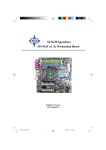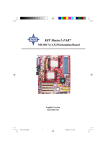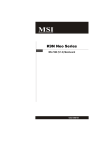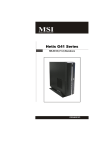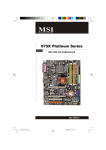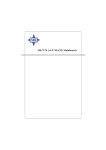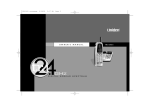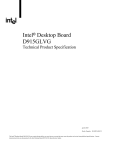Download MSI Barebone Hetis 915 Black Lite
Transcript
Hetis 915 User’s Guide G52-B6289X1 FCC-B Radio Frequency Interference Statement This equipment has been tested and found to comply with the limits for a class B digital device, pursuant to part 15 of the FCC rules. These limits are designed to provide reasonable protection against harmful interference when the equipment is operated in a commercial environment. This equipment generates, uses and can radiate radio frequency energy and, if not installed and used in accordance with the instruction manual, may cause harmful interference to radio communications. Operation of this equipment in a residential area is likely to cause harmful interference, in which case the user will be required to correct the interference at his own expense. Notice 1 The changes or modifications not expressly approved by the party responsible for compliance could void the user’s authority to operate the equipment. Notice 2 Shielded interface cables and AC. power cord, if any, must be used in Micro-Star International Hetis 915 This device complies with Part 15 of the FCC Rules. Operation is subject to the following two conditions: (1) this device may not cause harmful interference, and (2) this device must accept any interference received, including interference that may cause undesired operation. ii Copyright Notice The material in this document is the intellectual property of MICROSTAR INTERNATIONAL. We take every care in the preparation of this document, but no guarantee is given as to the correctness of its contents. Our products are under continual improvement and we reserve the right to make changes without notice. Trademarks All trademarks are the properties of their respective owners. Intel® and Pentium® are registered trademarks of Intel Corporation. PS/2 and OS®/2 are registered trademarks of International Business Machines Corporation. Windows® 95/98/2000/NT/XP are registered trademarks of Microsoft Corporation. Netware® is a registered trademark of Novell, Inc. Award® is a registered trademark of Phoenix Technologies Ltd. AMI® is a registered trademark of American Megatrends Inc. Revision History Revision V1.0 Revision History First Release iii Date March 2005 Safety Instructions 1. 2. 3. 4. 5. 6. 7. 8. 9. 10. 11. 12. Always read the safety instructions carefully. Keep this User’s Manual for future reference. Keep this equipment away from humidity. Lay this equipment on a reliable flat surface before setting it up. The openings on the enclosure are for air convection hence pro tects the equipment from overheating. DO NOT COVER THE OPENINGS. Make sure the voltage of the power source and adjust properly 115/230V before connecting the equipment to the power inlet. Place the power cord such a way that people can not step on it. Do not place anything over the power cord. Always Unplug the Power Cord before inserting any add-on card or module. All cautions and warnings on the equipment should be noted. Never pour any liquid into the opening that could damage or cause electrical shock. If any of the following situations arises, get the equipment checked by a service personnel: - The power cord or plug is damaged. - Liquid has penetrated into the equipment. - The equipment has been exposed to moisture. - The equipment has not work well or you can not get it work according to User’s Manual. - The equipment has dropped and damaged. - The equipment has obvious sign of breakage. Do not leave this equipment in an unconditioned environment with storage temperature above 500 C (1220F). Extreme heat may damage the equipment. CAUTION: Danger of explosion if battery is incorrectly replaced. Replace only with the same or equivalent type recommended by the manufacturer. iv CONTENTS Chapter 1. Getting Started..........................................................................1-1 1.1 System Specifications .................................................................. 1-2 1.2 System Configuration .................................................................... 1-4 1.3 Thermal Solution .......................................................................... 1-10 Chapter 2. Introducing Mainboard............................................................2-1 2.1 Mainboard Layout........................................................................2-2 2.2 CPU...............................................................................................2-4 Introduction to LGA 775 CPU.....................................................2-4 CPU & Cooler Installation...........................................................2-5 2.3 Memory .......................................................................................... 2-8 Introduction to DDR SDRAM......................................................2-8 DIMM Module Combination.........................................................2-9 Installing DDR Modules..............................................................2-9 2.4 Power Supply .............................................................................. 2-10 ATX 20-Pin Power Connector: ATX1.......................................2-10 ATX 12V Power Connector: JPW1..........................................2-10 2.5 Front Panel ................................................................................. ..2-11 Audio Ports..............................................................................2-11 USB Ports................................................................................2-11 IEEE 1394 Port (Standard only) ............................................... 2-11 2.6 Rear Panel ................................................................................... 2-12 Mouse/Keyboard Connectors ................................................. 2-12 Audio Port Connectors............................................................2-13 VGA Port.................................................................................2-13 Digital Panel Connector (DVI)(Standard only) ........................ 2-14 LAN (RJ-45) Jack....................................................................2-15 USB Ports................................................................................2-15 Serial Ports.............................................................................2-16 IEEE 1394 Port (Standard only)...............................................2-16 S-Video Out Connector (Standard only) ................................ 2-17 RCA Connector: TV1 (Standard only).....................................2-17 2.7 Connectors .................................................................................. 2-18 IDE Connector: IDE1.................................................................2-18 Card Reader Connector: CR1 .................................................. 2-18 Serial ATA Connectors: SATA1/SATA2...................................2-19 v Fan Power Connectors: CPU_F2/CPU_F3................................2-19 Front Panel Connectors: JFP1.................................................2-20 CD-in Connector: JCD1.............................................................2-20 On-Board RCA out Connector: J2 (Standard only)..................2-21 Internal Speaker Connector: CON1..........................................2-21 2.8 Jumper ......................................................................................... 2-22 Clear CMOS Jumper: JBAT1....................................................2-22 2.9 Slot ............................................................................................... 2-23 PCI Express Slot: PCIE_1 (For Riser Card Use Only)..............2-23 Chapter 3. System Assembly .................................................................... 3-1 3.1 Overview ....................................................................................... 3-2 Installation Tools ......................................................................... 3-2 Sc rews ....................................................................................... 3-2 Checking the Items ..................................................................... 3-3 3.2 Installation Procedures .................................................................. 3-4 1. Removing Cover ..................................................................... 3-4 2. Installing HDD .......................................................................... 3-5 3. Installing Optical Drive ............................................................ 3-6 4. Installing Card Reader (Optional) .......................................... 3-7 5. Installing Memory Modules ..................................................... 3-8 6. Installing CPU .......................................................................... 3-9 7. Installing CPU Cooler ............................................................ 3-10 8. Restoring Chassis Cover & Installing Footstand ............... .3-11 Chapter 4. BIOS Setup.................................................................................4-1 Entering Setup....................................................................................4-2 Selecting the First Boot Device.................................................4-2 Control Keys..............................................................................4-3 Getting Help...............................................................................4-3 Main Menu.................................................................................4-3 Default Settings.........................................................................4-3 The Main Menu...................................................................................4-4 Standard CMOS Features..................................................................4-6 Advanced BIOS Features..................................................................4-8 Advanced Chipset Features............................................................4-10 Integrated Peripherals.......................................................................4-11 Power Management Features..........................................................4-14 PNP/PCI Configurations....................................................................4-17 H/W Monitor......................................................................................4-18 vi BIOS Setting Password....................................................................4-19 Load Fail-Safe/Optimized Defaults...................................................4-20 Chapter 5. Introduction to Realtek ALC880..........................................5-1 Installing the Realtek HD Audio Driver.................................................5-2 Installation for Windows 2000/XP......................................................5-2 Software Configuration......................................................................5-4 Sound Effect......................................................................................5-5 Audio IO.............................................................................................5-6 Mixer..................................................................................................5-9 Microphone.......................................................................................5-12 3D Audio Demo.................................................................................5-13 Information........................................................................................5-14 Using 2-, 4-, 6- & 8- Channel Audio Function...................................5-15 vii Getting Started 1 Congratulations for purchasing Hetis 915 (MS-6289) barebone. Hetis barebone is your best Slim PC choice. Based on the “all-in-one” design idea, Hetis provides 6 USB ports, 2 full PCI slots for expansion. With the fantastic appearance and small form factor, it can easily be set anywhere. The feature packed platform also gives you an exciting PC experience. Chapter 1 1.1 System Specifications Mainboard Model † MS-7137 v1.0, 334mm (L) x 190mm (W), 5 mounting holes, 4 layer proprietary form factor CPU †Supports Intel Pentium 4 Prescott processors in LGA775 package. †Supports up to Celeron-D/Pentium 4 3XX, 56X and 66X Series 533/ 800MHz FSB sequence processor or higher speed. †Supports Intel® Hyper-Threading Technology (For the latest information about CPU, please visit http://www.msi. com.tw/program/products/slim_pc/slm/pro_slm_cpu_support.php) Chipset † Intel® 915GL chipset - Supports FSB 800/533MHz - Supports DDR 333/400 memory interface - Integrated graphics controller. † Intel® ICH6 chipset - Hi-Speed USB (USB2.0) controller, 480Mb/sec, 6 ports - 2 Serial ATA/150 ports - 2 channel Ultra ATA 66/100 bus Master IDE controller - PCI Master v2.3, I/O APIC - Supports both ACPI and legacy APM power management MainMemory † Supports two unbuffered DIMM of 2.6 Volt DDR SDRAM † Supports up to 2GB memory size without ECC † Supports dual channel 333/400 MHz (For the updated supporting memory modules, please visit http://www.msi.com. tw/program/products/mainboard/mbd/pro_mbd_trp_list.php.) Slot † PCI(V2.3) *2 through riser card 1-2 Getting Started On-Board Peripherals † Front I/O - Audio Ports (Headphone-Out x 1, Mic-In x 1) - USB2.0 Ports x 2 - IEEE 1394 (4pins) x 1 (For Standard Version) † Rear I/O - PS/2 keyboard/Mouse x 2 - Serial Ports x 2 - VGA Port x 1 - Audio Ports (Line-In x 1, Line-Out x 1, Mic-In x 1, RS-Out x 1, C/S Out x 1, SS-Out x 1) - USB2.0 Ports x 4 - RJ45 LAN Jack x 1 For Standard Version - IEEE 1394 (6pins) x 1 -DVI - S-Video Out - RCA Out Audio † 7.1-channel HD audio codec Realtek ALC880 LAN † Intel® Gigabit LAN On-BoardGraphics † Intel GMA 900 graphics: - Incredible graphics for photos, videos and games. - High Definition TV (HDTV) display resolution for a wonderful enter tainment experience Chassis Dimension † 330mm (D) x 320mm (W) x 94mm (H) 1-3 Chapter 1 1.2 System Configuration Standard Version Front View 1. Mic-in (pink), Headphone-out (green) 2. 2 x USB 2.0 Ports 3. 4-pin IEEE 1394 Port 4. Power Button & Power LED 5. 6. 7. 8. 1-4 HDD LED Optical Drive Eject/Close Button Optical Drive (optional) Card Reader Drive (optional) Getting Started Rear View 1. Voltage Selector 2. Power Jack 3. Ventilation Hole 4. 4 x USB 2.0 Ports 5. PS/2 Mouse 6. PS/2 Keyboard 7. Serial Ports 8. DVI Port 9. S-Video out 10. Mic-in 12. Power On/Off Switch 13. Support Bracket Spring 14. RJ-45 LAN Jack 15. 6-pin IEEE 1394 Port 16. Expansion Slots 17. VGA Port 18. Line-out 19. Line-in 20. RCA out 21. RS-Out 11. SS-Out 22. C/S-Out 1-5 Chapter 1 Lite Version Front View 1. Mic-in (pink), Headphone-out (green) 2. 2 x USB 2.0 Ports 3. Power Button & Power LED 4. 5. 6. 7. 1-6 HDD LED Optical Drive Eject/Close Button Optical Drive (optional) Card Reader Drive (optional) Getting Started Rear View 1. 2. 3. 4. 5. 6. 7. 8. 9. Voltage Selector Power Jack Ventilation Hole 4 x USB 2.0 Ports PS/2 Mouse PS/2 Keyboard Serial Ports Mic-in SS-Out 10. Power On/Off Switch 11. Support Bracket Spring 12. RJ-45 LAN Jack 13. Expansion Slots 14. VGA Port 15. Line-out 16. Line-in 17. RS-Out 18. C/S-Out 1-7 Chapter 1 Connecting to External Devices 1-8 Getting Started Chassis Design †Dimension: 330mm (D) x 320mm (W) x 94mm (H) † Minimized screw structure † Detachable bay housing † Multiple ventilation holes 1. CPU Fan Ventilation Hole 4. Power Supply Ventilation Hole 2. System Ventilation Hole 5. System Ventilation Hole 3. System Fan Ventilation Hole 6. Release Button of Front I/O Door 1-9 Chapter 1 1.3 Thermal Solution To prevent the system from overheating, we have adopted a specially designed CPU cooler and multiple ventilation holes for better cooling effects. The specially designed CPU cooler supports Intel® LGA775Prescott™ and Celeron-D™ . The following figures illustrate how the system fan effectively exhausts hot air through multiple ventilation holes. CPU Fan Air Flow Direction Air In Air Out Air Out 1-10 Getting Started Po w e r Po w e r Supply Fan Supply Sy stem Fan Ventilation Hole Ventilation Hole front panel 1-11 Chapter 1 System Air Flow Direction Po w e r Supply Po w e r Fan Supply System Fan front panel After the installation is completed, please keep other objects away from the ventilation hole at least 2.5cm and above. Do not block the ventilation hole. 1-12 Introducing Mainboard 2 This chapter tells you basics of the CPU, memory modules, and expansion cards, as well as how to setup the jumpers on the mainboard. Also, it provides the instructions on connecting the peripheal devices, such as the mouse, keyboard, etc. While doing the installation, be careful in holding the components and follow the installation procedures. Chapter 2 2.1 Mainboard Layout Top: LAN Jack Bottom: USB ports Top: IEEE 1394 port Bottom: USB ports Top : mouse Botto m: keyboard Top : COM 1 Bottom: COM 2 Top : VGA Port Bottom: DVI Port S-Video Out T:Lin e-In M: Line-Ou t B:Mic J2 CHRONTEL CH70 21A-TEF VI A VT6 307 Win bond W836 27TH F JCD1 CHRONTEL CH7307 TC-DEF In tel 82541 P1 Re altek ALC880 Intel ICH6 BIOS CPU_F3 PC IE_1 ATX1 SATA2 SATA1 In tel 915GL CR1 IDE1 JBAT1 DIMM2 DIMM1 BATT + JPW1 CPU_F 2 JFP1 CON1 CASE_OPEN1 AUDIO2 AUDIO1 USB2 USB1 J1394-1 MS-7137 (V1.X) Mainboard (Standard Version) 2-2 Introducing Mainboard Top: LAN Jack Bottom: USB ports USB ports Top : mouse Botto m: keyboard Top : COM 1 Bottom: COM 2 VGA Port T:Lin e-In M: Line-Ou t B:Mic Win bond W836 27TH F JCD1 Intel 8254 1P1 Realtek ALC880 Intel ICH6 BIOS CPU_F3 PC IE_1 AT X1 SATA2 SATA1 Inte l 915GL CR1 IDE1 JBAT1 DIMM 2 DIMM1 BAT T + JPW1 CPU_F2 JFP1 CON1 CASE_OPEN1 AUDIO2 AUDIO1 USB2 USB1 MS-7137 (V1.X) Mainboard (Lite Version) 2-3 Chapter 2 2.2 CPU The mainboard supports Intel® Pentium 4 Prescott/Tejas processor. The mainboard uses a CPU socket called LGA775. When you are installing the CPU, make sure to install the cooler to prevent overheating. If you do not have the CPU cooler, contact your dealer to purchase and install them before turning on the computer. MSI Reminds You... Overheating Overheating will seriously damage the CPU and system, always make sure the cooling fan can work properly to protect the CPU from overheating. Replacing the CPU While replacing the CPU, always turn off the power supply or unplug the power supply’s power cord from grounded outlet first to ensure the safety of CPU. Overclocking This motherboard is designed to support overclocking. However, please make sure your components are able to tolerate such abnormal setting, while doing overclocking. Any attempt to operate beyond product specifications is not recommended. We do not guarantee the damages or risks caused by inadequate operation or beyond product specifications. Introduction to LGA 775 CPU The pin-pad side of LGA 775 CPU. The surface of LGA 775 CPU. Remember to apply some silicone heat transfer compound on it for better heat dispersion. Al i g nme n t Alignment Key Yellow triangle is the Pin 1 indicator Yellow triangle is the Pin 1 indicator 2-4 Introducing Mainboard CPU & Cooler Installation When you are installing the CPU, make sure the CPU has a cooler attached on the top to prevent overheating. If you do not have the cooler, contact your dealer to purchase and install them before turning on the computer. Meanwhile, do not forget to apply some silicon heat transfer compound on CPU before installing the heat sink/cooler fan for better heat dispersion. Follow the steps below to install the CPU & cooler correctly. Wrong installation will cause the damage of your CPU & mainboard. 1. The CPU has a land side cover on the bottom to protect the CPU contact from damage. Rotate it to make the pin 1 indicator (yellow triangle) in the right-bottom corner. 2. Take out the accompanying CPU Clip and rotate it for the same direction as the CPU (Pin 1 indicator is in the leftbottom corner). land side cover 4. Align the two pin 1 indicators (the triangles on the CPU & the CPU Clip), and use the CPU Clip to clip the CPU 3. Use 2 hands to remove the land side up, pressing the clips on both sides cover (if any). Please note not to to the center, as the arrows shown. touch the pins. MSI Reminds You... 1. Confirm if your CPU cooler is firmly installed before turning on your system. 2. Do not touch the CPU socket pins to avoid damaging. 3. The availability of the CPU land side cover depends on your CPU packing. 2-5 Chapter 2 5. The CPU socket has a plastic cap on it to protect the contact from damage. Before you have installed the CPU, always cover it to protect the socket pin. 6. Remove the cap from lever h in g e s i d e ( as t h e ar row shows). The pins of socket reveal. 7. Lift the load lever up and open the load plate. 8. Correctly align the triangle of CPU Clip with the CPU chamfer, and the square on the CPU Clip to the hook of the socket. 9. Use your thumb and the middle fingers to push the clips to release the CPU, then press down the CPU with your index finger to allow the whole module to be installed onto the CPU socket. 2-6 10.The CPU is installed well on the CPU socket. Introducing Mainboard 11. Visually inspect if the CPU is seated well into the socket, then remove the CPU Clip with 2 fingers. Then cover the load plate onto the package. 12. Press down the load lever lightly onto the load plate, and then secure the lever with the hook under retention tab. 13. Align the holes on the mainboard with the heats ink. Loc k the cooler until its four screws fixed on the mainboard. Note:If you want to uninstall the CPU, align the 4 points (see Point 8 for details) again and push the clip to lift up the CPU. MSI Reminds You... 1. Check the information in PC Health Status of H/W Monitor in BIOS (Chapter 4) for the CPU temperature. 2. Whenever CPU is not installed, always protect your CPU socket pin with the plastic cap covered to avoid damaging. 3. Please note that the mating/unmating durability of the CPU is 20 cycles. Therefore we suggest you do not plug/unplug the CPU too often. 2-7 Chapter 2 2.3 Memory The mainboard provides two 184-pin unbuffered DDR333/DDR400 DDR SDRAM, and supports the memory size up to 2GB without ECC. To operate properly, at least one DIMM module must be installed. (For the updated supporting memory modules, please visit http://www. msi.com.tw/program/products/mainboard/mbd/pro_mbd_trp_list.php ) DDR DIMM Slots (DDR 1~2) Introduction to DDR SDRAM DDR (Double Data Rate) SDRAM is similar to conventional SDRAM, but doubles the rate by transferring data twice per cycle. It uses 2.5 volts as opposed to 3.3 volts used in SDR SDRAM, and requires 184-pin DIMM modules rather than 168-pin DIMM modules used by SDR SDRAM. 2-8 Introducing Mainboard DIMM Module Combination Install at least one DIMM module on the slots. You can install either single- or double-sided modules in any order to meet your own needs. Memory modules can be installed in any combination as follows: Slot Memory Module DDR 1 (Bank 0 & 1) DDR 2 (Bank 2 & 3) S/D 128MB~1GB S/D 128MB~1GB Maximum System Memory Supported S: Single Side Total Memory 128MB~2GB D: Double Side Installing DDR Modules 1. 2. 3. The DDR DIMM has only one notch on the center of module. The module will only fit in the right orientation. Insert the DIMM memory module vertically into the DIMM slot. Then push it in until the golden finger on the memory module is deeply inserted in the socket. The plastic clip at each side of the DIMM slot will automatically close. Volt Notch MSI Reminds You... You can barely see the golden finger if the module is properly inserted in the socket. 2-9 Chapter 2 2.4 Power Supply The mainboard supports ATX power supply for the power system. Before inserting the power supply connector, always make sure that all components are installed properly to ensure that no damage will be caused. ATX 20-Pin Power Connector: ATX1 This connector allows you to connect to an power supply. To connect to the power supply, make sure the plug of the power supply is inserted in the proper orientation and the pins are aligned. Then push down the power supply firmly into the connector. ATX 12V Power Connector: JPW1 This 12V power connector is used to provide power to the CPU. ATX1 Pin Definition 1 11 10 20 ATX1 PIN SIGNAL PIN SIGNAL 1 3.3V 11 3.3V 2 3 3.3V GND 12 13 -12V GND 4 5 5V GND 14 15 PS_ON GND 6 7 5V GND 16 17 GND GND 8 9 PW_OK 5V_SB 18 19 -5V 5V 10 12V 20 5V JPW1 Pin Definition 2 1 PIN SIGNAL 4 3 1 2 GND GND 3 4 12V 12V JPW1 MSI Reminds You... These two connectors connect to the power supply and have to work together to ensure stable operation of the mainboard. 2-10 Introducing Mainboard 2.5 Front Panel IEEE 1394 4pins USB Ports (For Standard Version) Headphone-out Mic-in Audio Ports These audio ports allow you to connect front audio devices. Headphone-out MIC-in USB Ports The mainboard provides a UHCI (Universal Host Controller Interface) Universal Serial Bus root for attaching USB devices such as keyboard, mouse or other USB-compatible devices. You can plug the USB devices directly into these connectors. IEEE 1394 Port (For Standard Version) The front panel provides one IEEE 1394 port. This smaller one is designed for you to connect the IEEE 1394 device with external power. The IEEE 1394 high-speed serial bus complements USB by providing enhanced PC connectivity for a wide range of devices, including consumer electronics audio/video (A/V) appliances, storage peripherals, other PCs, and portable devices. 2-11 Chapter 2 2.6 Rear Panel RCA Out (For Standa rd Version) The Rear Panel provides the following connectors: Line-out IEEE 1394 6pins (For Standard Version) Line-in RS Serial Port LAN Jack VGA Port Mouse Keyboard USB Ports DVI Port MIC -in SS (For Standard S-Video Out Version) (For Standa rd Version) Serial Port CS Mouse/Keyboard Connectors The mainboard provides two standard PS/2® mini DIN connectors for attaching PS/2® mouse and keyboard. Mouse Pin Definition PS/2 Mouse (6-pin Female) 6 5 3 4 2 6 1 PIN SIGNAL DESCRIPTION 1 2 3 4 5 6 Mouse DATA NC GND VCC Mouse Clock NC Mouse DATA No connection Ground +5V Mouse clock No connection 5 Keyboard Pin Definition 3 4 2 1 PS/2 Keyboard (6-pin Female) PIN 1 2 3 4 5 6 SIGNAL Keyboard DATA NC GND VCC KeyboardClock NC 2-12 DESCRIPTION Keyboard DATA No connection Ground +5V Keyboard clock No connection Introducing Mainboard Audio Port Connectors The left 3 audio jacks are for 2-channel mode for stereo speaker output: Line Out is a connector for Speakers or Headphones. Line In is used for external CD player, Tape player, or other audio devices. Mic is a connector for microphones. However, there is an advanced audio application provided by Realtek ALC880 to offer support for 7.1-channel audio operation and can turn rear audio connectors from 2-channel to 4-/5.1-/7.1- channel audio. Rear Speaker Out (in 7.1CH / 5.1CH) Line In Line Out Center/Subwoofer Speaker Out ( in 7.1CH / 5.1CH) M IC Side Surround Out (in 7.1CH) VGA Port The mainboard provides one DB 15-pin female connector to connect a VGA monitor. VGA Port Pin Definition 5 15 1 11 DB 15-Pin Female Connector PIN SIGNAL DESCRIPTION 1 2 3 4 5 6 7 8 9 10 11 12 13 14 15 Red Green Blue Not used Ground Ground Ground Ground Power Ground Not used SDA Horizontal Sync Vertical Sync SCL 2-13 Chapter 2 Digital Panel Connector (DVI)(Standard only) The mainboard provides a DVI (Digital Visual Interface) connector which allows you to connect an LCD monitor. The DVI connector provides a high-speed digital interconnection between the computer and its display device. To connect a LCD monitor, simply plug your monitor cable into the DVI connector on the mainboard, and make sure that the other end of the cable is properly connected to your monitor. (refer to your monitor manual for more information.) DVI connector 1 8 17 24 LCD Monitor DVI Port Pin Definition DVI Connector Pin 1 2 3 4 5 6 7 8 9 10 11 12 Signal Assignment T.M.D.S.* Data2T.M.D.S. Data2+ T.M.D.S. Data2/4 Shield T.M.D.S. Data4T.M.D.S. Data4+ DDC Clock DDC Data N/C T.M.D.S. Data1T.M.D.S. Data1+ T.M.D.S. Data1/3 Pin 13 14 15 16 17 18 19 20 21 22 23 24 Signal Assignment T.M.D.S. Data3+ +5V GND (for +5V) Hot Plug Detect T.M.D.S. Data0T.M.D.S. Data0+ T.M.D.S. Data0/5 Shield T.M.D.S. Data5T.M.D.S. Data5+ T.M.D.S. Clock Shield T.M.D.S. Clock+ T.M.D.S. Clock- *T.M.D.S. Technology The graphics dat a sen t to the digit al monito r use Transit ion Minimi zed Different ial Si gnali ng (T.M.D.S.)techn ology. TMDS uses an enco di ng algorith m to 8-bit s of da ta into a 10-bi t t ransit ion mi nimi xed , DC balanced character, whi ch are transi tio nmi nimi zed t o reduce EMI wi th co pp er cables an d DC-balanced for tran smissio n over fi ber opti c cables. Th e TMDS a lg orit hm also p ro vi des ro bu st clock reco very for great er skew tolerance wi th lon ger cables or low cost sh ort cables. 2-14 Introducing Mainboard LAN (RJ-45) Jack The mainboard provides 1 standard RJ-45 jack for connection to single Local Area Network (LAN). This Giga-bit LAN enables data to be transferred at 1000, 100 or 10Mbps. You can connect a network cable to it. Giga-bit LAN Pin Definition 8 1 RJ-45 LAN Jack PIN SIGNAL DESCRIPTION 1 D0P Differential Pair 0+ 2 D0N Differential Pair 0- 3 D1P Differential Pair 1+ 4 D2P Differential Pair 2+ 5 D2N Differential Pair 2- 6 D1N Differential Pair 1- 7 D3P Differential Pair 3+ 8 D3N Differential Pair 3- USB Ports The mainboard provides a UHCI (Universal Host Controller Interface) Universal Serial Bus root for attaching USB devices such as keyboard, mouse or other USB-compatible devices. You can plug the USB device directly into the connector. The mainboard supports USB1. 1 & 2.0 devices. USB Port Description 1 5 2 6 3 7 4 PIN SIGNAL DESCRIPTION 8 1 2 3 4 5 6 7 8 VCC -Data 0 +Data0 GND VCC -Data 1 +Data 1 GND +5V Negative Data Channel 0 Positive Data Channel 0 Ground +5V Negative Data Channel 1 Positive Data Channel 1 Ground USB Ports 2-15 Chapter 2 Serial Ports The mainboard offers two 9-pin male DIN connectors as serial ports. The ports are 16550A high speed communication ports that send/receive 16 bytes FIFOs. You can attach a serial mouse or other serial devices directly to the connectors. Serial Port Pin Definition 1 2 3 4 5 PIN SIGNAL DESCRIPTION 1 2 DCD SIN Data Carry Detect Serial In or Receive Data 6 7 8 9 3 4 SOUT DTR Serial Out or Transmit Data Data Terminal Ready 9-Pin Male DIN Connector 5 6 GND DSR Ground Data Set Ready 7 8 RTS CTS Request To Send Clear To Send 9 RI Ring Indicate IEEE 1394 Port (For Standard Version) The back panel provides one standard IEEE 1394 port. The standard IEEE 1394 port connects to IEEE 1394 devices without external power. The IEEE 1394 high-speed serial bus complements USB by providing enhanced PC connectivity for a wide range of devices, including consumer electronics audio/video (A/V) appliances, storage peripherals, other PCs, and portable devices. 1394 Port 2-16 Introducing Mainboard S-Video Out Connector (For Standard Version) The mainboard provides a S-Video Out connector for video-out function which allows you to output the image to a TV or video device. Simply plug one end of the S-Video cable into the S-Video Out connector on the mainboard, and the other end to the video input connector on your TV or video device. Some TVs and video devices may support such kind of input connector. For the correct connection, please refer to the TVs and video devices' manuals for more information. S-Video Out TV Projector RCA Connector: TV1 (Standard only) You can connect a TV or video device to TV1 connector for videoout function which allows you to output the image to a TV or video device. TV TV1 Connector Projector 2-17 Chapter 2 2.7 Connectors . IDE Connector: IDE1 The mainboard has a 32-bit Enhanced PCI IDE and Ultra DMA 33/ 66/100 controller that provides PIO mode 0~4, Bus Master, and Ultra DMA/33/66/100 function. The connectors on the mainboard allows you to connect to the IDE devices: HDD & CD-ROM. IDE1 Card Reader Connector: CR1 The mainboard provides a connector to connect the Card Reader on the Front Panel. CR1 2-18 Introducing Mainboard Serial ATA Connectors: SATA1/SATA2 The southbridge of this mainboard is ICH6 which supports two serial connectors SATA1& SATA2. SATA1/SATA2 are dual high-speed Serial ATA interface ports. Each supports 1st generation serial ATA data rates of 150 MB/s. The connectors are fully compliant with Serial ATA 1.0 specifications. The Serial ATA connector allows you to connect the hard disk device of Serial ATA interface. SATA1/ SATA2 Pin Definition 1 7 SATA1/SATA2 PIN SIGNAL PIN SIGNAL 1 GND 2 TXP 3 5 TXN RXN 4 6 GND RXP 7 GND Fan Power Connectors: CPU_F2/CPU_F3 The CPU_F2(processor fan) and CPU_F3 (system fans) support system cooling fan with +12V. It supports three-pin head connector. When connecting the wire to the connectors, always take note that the red wire is the positive and should be connected to the +12V, the black wire is Ground and should be connected to GND. The mainboard has a ADT7467 chipset to detect CPU/fab temperature, you must use a specially designed fan with speed sensor to take advantage of the CPU fan control. GND Sensor +12V GND +12V Sensor CPU_F3 CPU_F2 MSI Reminds You... 1. Always consult the vendors for proper CPU cooling fan. 2. Please refer to the recommended CPU fans at Intel® official website. 2-19 Chapter 2 Front Panel Connectors: JFP1 The mainboard provides one front panel connector for you to connect to the front panel switches and LEDs. JFP1 is compliant with Intel® Front Panel I/O Connectivity Design Guide. 10 9 Reset Switch Power Switch Power LED 2 1 HDD LED JFP1 JFP1 Pin Definition PIN SIGNAL DESCRIPTION 1 2 HD_LED_P FP PWR/SLP Hard disk LED pull-up MSG LED pull-up 3 4 HD_LED_N FP PWR/SLP Hard disk active LED MSG LED pull-up 5 6 RST_SW_N PWR_SW_P Reset Switch low reference pull-down to GND Power Switch high reference pull-up 7 8 RST_SW_P PWR_SW_N Reset Switch high reference pull-up Power Switch low reference pull-down to GND 9 RSVD_DNU Reserved. Do not use. CD-in Connector: JCD1 The connector is for CD-ROM audio connector. L GND R JCD1 2-20 Introducing Mainboard RCA out Connector: J2 (For Standard Version) The mainboard provides a TV-out connector for you to connect to a TV or video device. J2 Internal Speaker Connector: CON1 This connector is used to connect the built-in speaker. CON1 2-21 Chapter 2 2.8 Jumper The motherboard provides the following jumpers for you to set the computer’s function. This section will explain how to change your motherboard’s function through the use of jumpers. Clear CMOS Jumper: JBAT1 There is a CMOS RAM on board that has a power supply from external battery to keep the system configuration data. With the CMOS RAM, the system can automatically boot OS every time it is turned on. If you want to clear the system configuration, use the JBAT1 (Clear CMOS Jumper ) to clear data. Follow the instructions below to clear the data: 1 1 3 3 1 JBAT1 Keep Data Clear Data MSI Reminds You... You can clear CMOS by shorting 2-3 pin while the system is off. Then return to 1-2 pin position. Avoid clearing the CMOS while the system is on; it will damage the mainboard. 2-22 Introducing Mainboard 2.9 Slot PCI Express Slot: PCIE_1 (For Riser Card Use Only) The mainboard provides one PCI Express slot. The PCI-E slot allows you to insert Riser Cards. The Riser Cards are included in the barebone. The Riser Cards allows you to insert two expansion card. You can insert any type of PCI cards to meet your needs. When adding or removing expansion cards, make sure that you unplug the power supply first. Meanwhile, read the documentation for the expansion card to make any necessary hardware or software settings. Riser Card PCI Express slot 2-23 System Assembly System Assembly 3 This chapter provides you with the installation procedures of Midas barebone. It is useful for you to read the information of mainboard setup before assembling the whole system. 3-1 Chapter 3 3.1 Overview The built-in MS-7137 mainboard is designed for Hetis barebone only. Except MS-7137 mainboard, the built-in components of the barebone include power supply. In this chapter we’ll show you how to install CPU, Card Reader, HDD, Optical Drives and CPU Cooler. Installation Tools Gloves Screw Driver Screws Two types of screws are used in assembling the barebone: round-headed screw, thumb screw. Round-headed screw: This type of screw is used to attach the HDD and card reader to the tray. Thumb screw: This type of screw is used to fasten the chassis cover to the chassis. 3-2 System Assembly Checking the Items Before assembling your system, please check the items listed below for basic system operation. The Footstand and the CPU cooler are included in the package, other items are optional. Footstand CPU Cooler CPU (Optional) Optical Drive (Optional) IDE or SATA HDD (Optional) DDR SDRAM (Optional) Card Reader (Optional) 3-3 Chapter 3 3.2 Installation Procedures 1. Removing Cover Unlock the two screws on the backplane with hands. Remove the chassis cover. Press the level on the support bracket spring to release it. Unlock the screw on the front panel to release the drive cage. 3-4 System Assembly 2. Installing HDD Lift the drive cage to slide aside. Pull the HDD tray forwards to remove it from the chassis. Put the HDD in the HDD tray and use 4 screws to fix it on both sides. Connect the cable and the power cord to the HDD, then put the HDD tray back to secure it on the drive cage. 3-5 Chapter 3 3. Installing Optical Drive Pull the lock brackets outwards on the both sides to release. Insert the optical drive and push the lock brackets back to fix it. Connect the cable and the power cord to the optical drive, then restore the drive cage. Lock the screw on the front panel to fix the drive cage. 3-6 System Assembly 4. Installing Card Reader (Optional) Use the screwdriver to unlock the card reader cage. Insert the card reader into the cage with 15 degree angle. Insert the LED into the cage and lock the card reader with two screws. Restore the card reader back and connect the cable to the CR1 connector on the mainboard. 3-7 Chapter 3 5. Installing Memory Modules Locate the DIMM slots. Insert the DIMM vertically into the slot. Note: The DIMM has only one notch on the center of module. It will only fit in the right direction. 3-8 System Assembly 6. Installing CPU Locate the CPU socket. Pull the lever away from the socket and raise it up, then lift up the cover. Put the CPU onto the socket. Note: Make sure the pins are completely embedded into the socket. The CPU can only fit in the correct direction. Close the cover and the lever to complete the installaton. 3-9 Chapter 3 7. Installing CPU Cooler Place the CPU cooler onto the CPU socket and secure the four screws. Connect the CPU cooler’s power cord to the connector on the mainboard. 3-10 System Assembly 8. Restoring Chassis Cover & Installing Footstand Restore the support bracket. Restore the chassis cover. Lock the chassis cover with the screws. Put the PC on the footstand or lay on the rubber foots. Horizontal type 3-11 Tower type BIOS Setup Chapter 3. BIOS Setup BIOS Setup 4 This chapter provides information on the BIOS Setup program and allows you to configure the system for optimum use. You may need to run the Setup program when: ² An error message appears on the screen during the system boot up, and requests you to run SETUP. ² You want to change the default settings for customized features. MSI Reminds You... 1. The items under each BIOS category described in this chapte r a re u nde r c ont inu ous upd ate fo r b ette r s y s t em performance. Therefore, the description may be slightly different from the latest BIOS and should be held for reference only. 2. While booting up, the BIOS version is shown in the 1st line appearing after the memory count. It is usually in the format: example: A7137IMS V1.0BH 01/23/05 where: 1st digit refers to BIOS maker as A=AMI(R); W=AWARD(R) 2nd - 5th digit refers to the model number. 6th - 7th digit refers to the c ustomer, MS=all standard customers. V1.0BH refers to the BIOS version. 01/23/05 refers to the date this BIOS is released. 4-1 Chapter 4 Entering Setup Power on the computer and the system will start POST (Power On Self Test) process. W hen the message below appears on the screen, press <DEL> key to enter Setup. DEL: Setup Menu TAB: Logo F11: Boot Menu F10: Flash Recovery If the message disappears before you respond and you still wish to enter Setup, restart the system by turning it OFF and On or pressing the RESET button. You may also restart the system by simultaneously pressing <Ctrl>, <Alt>, and <Delete> keys. Selecting the First Boot Device You are allowed to select the 1st boot device without entering the BIOS setup utility by pressing <F11>. When the same message as listed above appears on the screen, press <F11> to trigger the boot menu. The POST messages might pass by too quickly for you to respond in time. If so, restart the system and press <F11> after around 2 or 3 seconds to activate the boot menu similar to the following. Select First Boot Device IDE-0 : IBM-DTLA-307038 CDROM : ATAPI CD-ROM DRIVE 40X M [Up/Dn] Select [RETURN] Boot [ESC] cancel The boot menu will list all the bootable devices. Select the one you want to boot from by using arrow keys and then pressing <Enter>. The system will boot from the selected device. The selection will not make changes to the settings in the BIOS setup utility, so next time when you power on the system, it will still use the original first boot device to boot up. 4-2 BIOS Setup Control Keys < ↑> Move to the previous item < ↓> Move to the next item < ←> Move to the item in the left hand < →> Move to the item in the right hand <Enter> Select the item <Esc> Jumps to the Exit menu or returns to the main menu from a submenu <+> Increase the numeric value or make changes <-> Decrease the numeric value or make changes <F6> Load Optimized Defaults <F7> Load Fail-Safe Defaults <F10> Save all the CMOS changes and exit Getting Help After entering the Setup utility, the first screen you see is the Main Menu. Main Menu The main menu displays the setup categories the BIOS supplies. You can use the arrow keys ( ↑↓ ) to select the item. The on-line description for the selected setup category is displayed at the bottom of the screen. Default Settings The preset Optimal Defaults of the BIOS setup program provide optimal performance settings for all devices and the system. MSI Reminds You... The items under each BIOS category described in this chapter are under continuous update for better system performance. Therefore, the description may be slightly different from the latest BIOS and should be held for reference only. 4-3 Chapter 4 The Main Menu Once you enter AMIBIOS NEW SETUP UTILITY, the Main Menu will appear on the screen. Use arrow keys to move among the items and press <Enter> to enter the sub-menu. Standard CMOS Features Use this menu for basic system configurations, such as time, date etc. Advanced BIOS Features Use this menu to setup the items of AMI® special enhanced features. Advanced Chipset Features Use this menu to change the values in the chipset registers and optimize your system’s performance. Integrated Peripherals Use this menu to specify your settings for integrated peripherals. Power M anagement Features Use this menu to specify your settings for power management. PNP/PCI Configurations This entry appears if your system supports PnP/PCI. H/W/ M onitor This entry shows the status of your CPU, fan, warning for overall system status. Load Fail-Safe Defaults Use this menu to load the default values set by the BIOS vendor for stable system performance. 4-4 BIOS Setup Load Optimized Defaults Use this menu to load the default values set by the mainboard manufacturer specifically for optimal performance of the mainboard. BIOS Setting Password Use this menu to set the password for BIOS. Save & Exit Setup Save changes to CMOS and exit setup. Exit Without Saving Abandon all changes and exit setup. 4-5 Chapter 4 Standard CMOS Features The items in Standard CMOS Features Menu includes some basic setup items. Use the arrow keys to highlight the item and then use the <+> or <-> keys to select the value you want in each item. Date (MM:DD:YY) This allows you to set the system to the date that you want (usually the current date). The format is <day> <month> <date> <year>. day Day of the week, from Sun to Sat, determined by BIOS. Read only. mon th The month from Jan. through Dec. date The date from 1 to 31 can be keyed by numeric function keys. year The year can be adjusted by users. Time (HH:MM:SS) This allows you to set the system time that you want (usually the current time). The time format is <hour> <minute> <second>. IDE Primary/Secondary/Third M aster/Slave Press <+> or <-> to select the hard disk drive type. The specification of hard disk drive will show up on the right hand according to your selection. Press <Enter> for the sub-menu of each item: 4-6 BIOS Setup Device/Vendor/Size This item shows the information about the specified item. Read-only. LBA/Large M ode This item allows you to enable or disable the LBA (Logical Block Address, the logical block size in hard disk) mode. Setting options: [Auto], [Disabled]. Hard Disk S.M.A.R.T. This allows you to activate the S.M.A.R.T. (Self-Monitoring Analysis & Reporting Technology) capability for the hard disks. S.M.A.R.T is a utility that monitors your disk status to predict hard disk failure. This gives you an opportunity to move data from a hard disk that is going to fail to a safe place before the hard disk becomes offline. Settings: [Auto], [Enabled], [Disabled]. System Information Press <Enter> to for the sub-menu of each item: M arket Name/M odel Name This item shows the the PC/Mainboard names (read only). Total System M emory/BIOS Version This item shows the memory status and BIOS version of your system (read only). **CPU Information** Genuine Intel (R)/CPU ID/uCode ID/CPU Frequency The three items show the CPU related information of your system (read only). 4-7 Chapter 4 Advanced BIOS Features Quick Boot Setting the item to [Enabled] allows the system to boot within 5 seconds since it will skip some check items. Available options: [Enabled], [Disabled]. Boot Sector Protection This function protects the BIOS from accidental corruption by unauthorized users or computer viruses. W hen enabled, the BIOS’ data cannot be changed when attempting to update the BIOS with a Flash utility. To successfully update the BIOS, you’ll need to disable this Boot Sector Protection function. You should enable this function at all times. The only time when you need to disable it is when you want to update the BIOS. After updating the BIOS, you should immediately re-enable it to protect it against viruses. Setting options: [Enabled], [Disabled]. NX Support NX (No eXecute) Support function is designed for memory buffer overflow protection, it can prevent viruses from proliferating. Settings: [Enabled], [Disabled]. C1E Support When The CPU ID>0F40 and is above 533MHz/2.8GHz or 800MHz/3.6GHz, you can enable C1E Support to lower the CPU power consumption while idle. Settings: [Enabled], [Disabled]. Hyper-Threading Function The processor uses Hyper-Threading technology to increase transaction rates and reduces end-user response times. The technology treats the two cores 4-8 BIOS Setup inside the processor as two logical processors that can execute instructions simultaneously. In this way, the system performance is highly improved. If you disable the function, the processor will use only one core to execute the instructions. Settings: [Enabled], [Disabled]. MSI Reminds You... Enabling the functionality of Hyper-Threading Technology for your computer system requires ALL of the following platform Components: * CPU: An Intel® Pentium® 4 Processor with HT Technology; * Chipset: An Intel® Chipset that supports HT Technology; * BIOS: A BIOS that supports HT Technology and has it enabled; * OS: An operating system that supports HT Technology. For more information on Hyper-threading Technology, go to: www.intel.com/info/hyperthreading Full Screen LOGO Display This item enables you to show the company logo on the bootup screen. Settings are: [Enabled] Shows a still image (logo) on the full screen at boot. [Disabled] Shows the POST messages at boot. Boot Sequence Press <Enter> and the following sub-menu appears. 1st/2nd/3rd Boot Device These items allow you to set the sequence of boot devices where BIOS attempts to load the operating system. Boot From Other Devices Setting the option to [Yes] allows the system to try to boot from other devices if the system fails to boot from the 1st/2nd/3rd boot device. Settings are: [Yes], [No]. MSI Reminds You... Available settings for “1st/2nd/3rd Boot Device” vary depending on the bootable devices you have installed. For example, if you did not install a floppy drive, the setting “Floppy” will not show up. 4-9 Chapter 4 Advanced Chipset Features MSI Reminds You... Change these settings only if you are familiar with the chipset. Configure DRAM Timing by SPD Selects whether DRAM timing is controlled by the SPD (Serial Presence Detect) EEPROM on the DRAM module. Setting options: [Disabled], [Enabled]. Int. VGA Memory Size Select The field specifies the size of system memory allocated for video memory. Setting options: [Disabled], [1MB], [8MB]. Aperture Size Select This setting controls just how much system RAM can be allocated to IGD (internal graphic display) for video purposes. The aperture is a portion of the PCI memory address range dedicated to graphics memory address space. Host cycles that hit the aperture range are forwarded to the IGD without any translation. The option allows the selection of an aperture size of [128MB], and [256 MB]. Video Function Configuration This allows you to set the video functions. DVMT M ode Select Use the field to select the mode of the digital monitor you use. Setting options: [Fixed Mode], [DVMT Mode], [Combo Mode]. 4-10 BIOS Setup Integrated Peripherals USB Controller This setting is used to enable/disable the onboard USB host controller. Setting options: [Disabled], [Enabled]. USB Device Legacy Support Set to [Enabled] if you need to use any USB 1.1/2.0 device in the operating system that does not support or have any USB 1.1/2.0 driver installed, such as DOS. Set to [Disabled] only if you want to use any USB device other than the USB mouse. Setting options: [Disabled], [Enabled], [Auto]. Onboard LAN Controller The item enables or disables the onboard LAN controller. Setting options: [Enabled], [Disabled]. Onboard LAN Option ROM The item enables or disables the initialization of the onboard LAN Boot ROMs during bootup. Selecting [Disabled] will speed up the boot process. Setting options: [Enabled], [Disabled]. OnBoard IEEE1394 Controller (Optional) This setting is used to enable/disable the onboard IEEE 1394 controller. Setting options: [Enabled], [Disabled]. Onboard Audio Controller This item is used to enable or disable the onboard Azalia (Audio Codec) controller. Selecting [Enabled] allows the mainboard to enable the onboard Azalia controller. Disable the function if you want to use other controller cards to connect an audio device. Settings: [Disabled] and [Enabled]. IDE Devices Configuration Press <Enter> to enter the sub-menu and the following screen appears: 4-11 Chapter 4 PCI IDE BusM aster Set this option to [Enabled] to specify that the IDE controller on the PCI local bus has bus mastering capability. Settings options: [Disabled], [Enabled]. I/O Devices Configuration Press <Enter> to enter the sub-menu and the following screen appears: COM Port 1/2 These items specify the base I/O port addresses of the onboard Serial Port 1 (COM A) / Serial Port 2 (COM B). Selecting [Auto] allows AMIBIOS to automatically determine the correct base I/O port address. Settings: [3F8/ IRQ4], [2F8/IRQ3], [3E8/IRQ4], [2E8/IRQ3] and [Disabled]. ATA/IDE Configuration, Configure SATA as These 2 items allow you to select the ATA/IDE and SATA configuration. Select [Disabled] in ATA/IDE Configuration if you want to disable both ATA/IDE configuration. Select [Compatible] or [Enhanced] to use the IDE, SATA and P-ATA devices. Refer to the following tables for details. ATA/IDE Configuration (Compatible) SATA Only [SATA 1//2] PATA Pri, SATA Sec [IDE1, SATA2] SATA Pri, PATA Sec [SATA1, IDE1] PATA Only [IDE1] 4-12 BIOS Setup ATA/IDE Configuration (Enhanced) IDE [IDE1, SATA 1/2] AHCI [IDE1, SATA 1/2] For the setting options of Configure SATA as, select [IDE] if you want to have SATA as IDE function. Select [AHCI] to allow the SATA to have Advanced Host Controller Interface (AHCI) feature, which supports improved serial ATA disk performance with native command queuing & native hot plug. 4-13 Chapter 4 Power Management Features MSI Reminds You... S3-related functions described in this section are available only when your BIOS supports S3 sleep mode. ACPI Standby State This item specifies the power saving modes for ACPI function. If your operating system supports ACPI, such as W indows 98SE, W indows ME, W indows 2000 and Windows XP, you can choose to enter the Standby mode in S1 (POS) or S3 (STR) fashion through the setting of this field. Options are: [S1/POS] The S1 sleep mode is a low power state. In this state, no system context is lost (CPU or chipset) and hardware maintains all system context. [S3/STR] The S3 sleep mode is a lower power state where the information of system configuration and open applications/files is saved to main memory that remains powered while most other hardware components turn off to save energy. The information stored in memory will be used to restore the system when a “wake up” event occurs. [Auto] BIOS determines the best setting automatically. Re-Call VGA BIOS from S3 Selecting [Enabled] allows BIOS to call VGA BIOS to initialize the VGA card when system wakes up (resumes) from S3 sleep state. The system resume time is shortened when you disable the function, but system will need an AGP driver to initialize the VGA card. Therefore, if the AGP driver of the card does not support the initialization feature, the display may work abnormally or not function after resuming from S3. 4-14 BIOS Setup Power Button Function This feature allows users to configure the Power Button function. Settings are: [Power Off] The power button functions as a normal power-on/ -off button. [Suspend] W hen you press the power button, the computer enters the suspend/sleep mode, but if the button is pressed for more than four seconds, the computer is turned off. Restore on AC Power Loss This setting specifies whether your system will reboot after a power failure or interrupt occurs. Available settings are: [Off] Leaves the computer in the power off state. [On] Leaves the computer in the power on state. [Last State] Restores the system to the previous status before power failure or interrupt occurred. Wakeup Event Setup Press <Enter> and the following sub-menu appears. Resume From S3 By USB Device The item allows the activity of the USB device to wake up the system from S3 (Suspend to RAM) sleep state. Setting options: [Disabled], [Enabled]. PowerOn by Keyboard This controls how and whether the PS/2 keyboard is able to power on the system. If you choose [Password], you must type the password to power on the system. Settings: [Disabled], [Password] and [Any Key]. Key board Password If PowerOn by Keyboard is set to [Password], then you can set a password in the field for the PS/2 keyboard to power on the system. PowerOn by M ouse The setting determines whether the system will be awakened from power saving modes when the PS/2 mouse input signal is detected. Setting options: [Disabled], [Any Key], [Left Button], [Right Button]. 4-15 Chapter 4 Resume by Ring An input signal on the serial Ring Indicator (RI) line (in other words, an incoming call on the modem) awakens the system from a soft off state. Resume by PCI/PCI-E Device This controls how and whether the system can be powered on by the devices installed on PCI/PCI-E slots. Setting options: [Disabled], [Enabled]. Resume by RTC Alarm This is used to enable or disable the feature of booting up the system on a scheduled time/date from the S3, S4, and S5 power off state. Setting options: [Disabled], [Enabled]. 4-16 BIOS Setup PNP/PCI Configurations This section describes configuring the PCI bus system and PnP (Plug & Play) feature. PCI, or Peripheral Component Interconnect, is a system which allows I/O devices to operate at speeds nearing the speed the CPU itself uses when communicating with its special components. This section covers some very technical items and it is strongly recommended that only experienced users should make any changes to the default settings. Graphic Adapter Priority This setting specifies which VGA card is your primary graphics ting options are: [IGD] The system initializes the IGD (internal graphic (for 915G only) [PCI/IGD] The system initializes the PCI graphic card first. If card is not available, it will initialize the IGD. (for adapter. Setdisplay) first. a PCI graphic 915G only) PCI Latency Timer This item controls how long each PCI device can hold the bus before another takes over. W hen set to higher values, every PCI device can conduct transactions for a longer time and thus improve the effective PCI bandwidth. For better PCI performance, you should set the item to higher values. Setting options: [32], [64], [96], [128], [160], [192], [224], [248]. 4-17 Chapter 4 H/W Monitor This section shows the status of your CPU, fan, overall system status, etc. Monitor function is available only if there is hardware monitoring mechanism Chassis Intrusion The field enables or disables the feature of recording the chassis intrusion status and issuing a warning message if the chassis is once opened. This item is available only when your mainboard has JCI1 jumper. To clear the warning message, set the field to [Reset]. The setting of the field will automatically return to [Enabled] later. Settings: [Enabled], [Reset], [Disabled]. PC Health Status Press <Enter> and the following sub-menu appears: CPU/System FAN Control This item enables or disables the Smart Fan feature. Smart Fan is an excellent feature which will adjust the CPU/System fan speed automatically depending on the CPU/System current temperature, avoiding the overheating to damage your system. Option: [Smart Fan], [High Speed]. CPU/System Temperature, CPU/SYSTEM FAN Speed, Vcore, +3.3V, +5.0V, +12.0V, +5VSB These items display the current status of all of the monitored hardware devices/components such as CPU voltages, temperatures and all fans’ speeds. 4-18 BIOS Setup BIOS Setting Password W hen you select this function, a message as below will appear on the screen: Type the password, up to six characters in length, and press <Enter>. The password typed now will replace any previously set password from CMOS memory. You will be prompted to confirm the password. Retype the password and press <Enter>. You may also press <Esc> to abort the selection and not enter a password. To clear a set password, just press <Enter> when you are prompted to enter the password. A mes sage will show up conf irming the pass word will be disabled. Once the password is disabled, the system will boot and you can enter Setup without entering any password. W hen a password has been set, you will be prompted to enter it every time you try to enter Setup. This prevents an unauthorized person from changing any part of your system configuration. 4-19 Chapter 4 Load Fail-Safe/Optimized Defaults The two options on the main menu allow users to restore all of the BIOS settings to the default Fail-Safe or Optimized values. The Optimized Defaults are the default values set by the mainboard manufacturer specifically for optimal performance of the mainboard. The Fail-Safe Defaults are the default values set by the BIOS vendor for stable system performance. W hen you select Load Fail-Safe Defaults, a message as below appears: Pressing Y loads the BIOS default values for the most stable, minimal system performance. W hen you select Load Optimized Defaults, a message as below appears: Pressing Y loads the default factory settings for optimal system performance. 4-20 Introduction to Realtek ALC 880 Introduction to Realtek ALC880 5 5 The mainboard is equipped with Realtek ALC880 chip, which provides support for 8-channel audio output, including 2 Front, 2 Rear, 2 Side, 1 Center and 1 Subwoofer channel. ALC880 allows the board to attach 2, 4, 6 or 8 speakers for better surround sound effect. The section will tell you how to install and use 2-, 4-, 6- or 8-channel audio function on the board. 5-1 Chapter 5 Installing the Realtek HD Audio Driver You need to install the driver for Realtek ALC880 codec to function properly before you can get access to 2-, 4-, 6- or 8- channel audio operations. Follow the procedures described below to install the drivers for different operating systems. Installation for Windows 2000/XP For W indows ® 2000, you must install W indows ® 2000 Service Pack4 or later before installing the driver. And for W indows ® XP, you must install W indows ® XP Service Pack1 or later before installing the driver. The following illustrations are based on Windows ® XP environment and could look slightly different if you install the drivers in different operating systems. 1. Insert the companion CD into the CD-ROM drive. The setup screen will automatically appear. 2. Click Realtek HD Audio Driver. Click here MSI Reminds You... The HD Audio Configuration software utility is under continuous update to enhance audio applications. Hence, the program screens shown here in this appendix may be slightly different from the latest software utility and shall be held for reference only. 5-2 Introduction to Realtek ALC 880 3. Click Next to install the Realtek High Definition Audio Driver. Clic k he r e 4. Click Finish to restart the system. Se le ct this option Clic k he r e 5-3 Chapter 5 Software Configuration After installing the audio driver, you are able to use the 2-, 4-, 6- or 8- channel audio feature now. Click the audio icon from the system tray at the lower-right corner of the screen to activate the HD Audio Configuration. It is also available to enable the audio driver by clicking the Azalia HD Sound Effect Manager from the Control Panel. 5-4 Introduction to Realtek ALC 880 Sound Effect Here you can select a sound effect you like from the Environment list. Load EQ Setting Reset EQ Setting EQ Setting On/Off Save Preset Delete EQ Setting You may choose the provided sound effects, and the equalizer will adjust automatically. If you like, you may also load an equalizer setting or make an new equalizer setting to save as an new one by using the “Load EQ Setting” and “Save Preset” button, click “Reset EQ Setting” button to use the default value, or click “Delete EQ Setting” button to remove a preset EQ setting. There are also other pre-set equalizer models for you to choose by clicking “Others” under the Equalizer part. Here it provides the Karaoke function which will automatically remove human voice (lyrics) and leave melody for you to sing the song. You may use the “up arrow” and “down arrow” button to raise/lower the key, and press the lower button to remove the human voice. Raise the key Remov e the human voice Lower the key 5-5 Chapter 5 Audio IO In this tab, you can easily configure your multi-channel audio function and speakers. You can choose a desired multi-channel operation here. a. Headphone for the common headphone b. 2CH Speaker for Stereo-Speaker Output c. 4CH Speaker for 4-Speaker Output d. 6CH Speaker for 5.1-Speaker Output e. 8CH Speaker for 8-Speaker Output (default setting) Realtek HD Audio Manager frees you from default speaker settings. Different from before, for each jack, they are not limited to perform certain functions. Instead, each jack is able to be chosen to perform either output (ex. playback) function or input (ex. Recording) function, all by your own choices. Please follow the steps below to use it: 1. Plug the speakers in any available jack. 2. Dialogue “connected device” will pop up for your selection. Please select the device you have plugged in. - If the device is being plugged into the correct jack, you will be able to find the icon beside the jack changed to the one that is same as your device. - If not correct, Realtek HD Audio Manager will guide you to plug the device into the correct jack. 5-6 Introduction to Realtek ALC 880 Correct M essage Assume to plug a headphone in the Green jack at back panel. The icon beside green jack become visible and the dialogue “connected device” pops up. Check the headphone, then click OK. As soon as OK is clicked, the icon beside green jack becomes “headphone” as your selection. Error M essage Assume to plug a headphone in the Blue jack at back panel. The icon beside Blue jack becomes visible and the dialogue “connected device” pops up (the default setting of blue jack is “Line-in”. Check the headphone anyway, then click OK. You should notice the icon beside blue jack remains the same without any change and the error message pops. Pop-screen check list 2CH Speakers configutaion - check the Front Speaker Out anyway. 4CH Speakers configuration - check the Front Speaker Out & Rear Speaker Out anyway. 6CH Speakers configuraion - check the Front Speaker Out / Rear Speaker Out & Center/ Subwoofer Speaker out anyway. 8CH Speakers configuraion - check the Front Speaker Out / Rear Speaker Out / Center/Subwoofer Speaker out & Side Speaker Out anyway. 5-7 Chapter 5 Test Speakers You can select the speaker by clicking it to test its functionality. The one you select will light up and make testing sound. If any speaker fails to make sound, then check whether the cable is inserted firmly to the connector or replace the bad speakers with good ones. Or you may click the auto test button to test the sounds of each speaker automatically. C e n te r Front Left Front Right Side Rig ht Subwoo fe r Side Left Rear Right Rear Left 5-8 Introduction to Realtek ALC 880 Mixer In the Mixer part, you may adjust the volumes of the rear and front panels individually. 1. Playback You can adjust the volume of the speakers that you pluged in front or rear panel by select the Realtek HD Audio rear output or Realtek HD Audio front output items. MSI Reminds You... Before set up, please make sure the playback devices are well plugged in the jacks on the rear or front panel. The Realtek HD Audio front output item will appear after you pluging the speakers into the jacks on the front panel. 2. Multi-Stream Function ALC880 supports an outstanding feature called Multi-Stream, which means you may play different audio sources simultaneously and let them output respectively from the indicated real panel or front panel. This feature is very helpful when 2 people are using the same computer together for different purposes. Click the button and the Mixer ToolBox menu will appear. Then check the Enable playback multi-streaming and the Update preferred playback device automatically items and click OK to save the setup. MSI Reminds You... We strongly recommend you to plug the speakers into the audio jacks on the back & front panel before enable the multi-stream function. 5-9 Chapter 5 W hen you are playing the first audio source (for example: use W indows Media Player to play DVD/VCD), the output will be played from the rear panel, which is the default setting. Then you must to select the Realtek HD Audio front output from the scroll list first, and use a different program to play the second audio source (for example: use W inamp to play MP3 files). You will find that the second audio source (MP3 music) will come out from the Line-Out audio jack of Front Panel. 5-10 Introduction to Realtek ALC 880 3. Recording If you want to use microphone to record, usually the microphone is connected to the MIC jack (the pink one) in the rear panel. You can start recording in this case. If you’d like to connect your microphone to the front audio panel, please select the Mic in at front panel (Pink) from the scroll list after connecting microphone to the front audio panel. MSI Reminds You... Only the speakers that plugged into the Line-Out jack (the green ne) on the back panel will be functional when you intend to listen to the audio that has been recorded from the microphone. 5-11 Chapter 5 Microphone In this tab you may set the function of the microphone. Select the Noise Suppression to remove the possible noise during recording, or select Acoustic Echo Cancelltion to cancel the acoustic echo druing recording. Also, please use the drop-down list to choose the recording source from Realtek HD Audio real input or Realtek HD Audio front input. 5-12 Introduction to Realtek ALC 880 3D Audio Demo In this tab you may adjust your 3D positional audio before playing 3D audio applications like gaming. You may also select different environment to choose the most suitable environment you like. 5-13 Chapter 5 Information In this tab it provides some information about this HD Audio Configuration utility, including Audio Driver Version, DirectX Version, Audio Controller & Audio Codec. You may also select the language of this utility by choosing from the Language list. Also there is a selection Show icon in system tray. Switch it on and an icon will show in the system tray. Right-click on the icon and the Audio Accessories dialogue box will appear which provides several multimedia features for you to take advantage of. 5-14 Introduction to Realtek ALC 880 Using 2-, 4-, 6- & 8- Channel Audio Function Connecting the Speakers W hen you have set the Multi-Channel Audio Function mode properly in the software utility, connect your speakers to the correct phone jacks in accordance with the setting in software utility. n 2-Channel M ode for Stereo-Speaker Output Refer to the following diagram and caption for the function of each phone jack on the back panel when 2-Channel Mode is selected. Back Panel 1 4 2 5 3 6 1 Line In 2 Line Out (Front channels) 3 MIC 4 Line Out (Rear channels, but no functioning in this mode) 5 Line Out (Center and Subwoofer channel, but no functioning in this mode) 6 Side Surround Out (Side channels, but no functioning in this mode) 5-15 Chapter 5 n 4-Channel M ode for 4-Speaker Output 4 1 2 5 3 6 Description: Connect two speakers to back panel’s Line Out connector and two speakers to the real-channel Line Out connector. 4-Channel Analog Audio Output 1 Line In 2 Line Out (Front channels) 3 MIC 4 Line Out (Rear channels) 5 Line Out (Center and Subwoofer channel, but no functioning in this mode) 6 Side Surround Out (Side channels, but no functioning in this mode) 5-16 Introduction to Realtek ALC 880 n 6-Channel M ode for 6-Speaker Output 4 1 2 5 3 6 Description: Connect two speakers to back panel’s Line Out connector, two speakers to the rear-channel and two speakers to the center/subwoofer-channel Line Out connectors. 6-Channel Analog Audio Output 1 Line In 2 Line Out (Front channels) 3 MIC 4 Line Out (Rear channels) 5 Line Out (Center and Subwoofer channel) 6 Side Surround Out (Side channels, but no functioning in this mode) 5-17 Chapter 5 n 8-Channel M ode for 8-Speaker Output 1 4 2 5 3 6 Description: Connect two speakers to back panel’s Line Out connector, two speakers to the rear-channel, two speakers to the c enter/ subwoofer-channel Line Out connectors, and two speakers to the side-channel Line Out connectors. 8-Channel Analog Audio Output 1 Line Out (Side channels) 2 Line Out (Front channels) 3 MIC 4 Line Out (Rear channels) 5 Line Out (Center and Subwoofer channel) 6 Side Surround Out (Side channels) 5-18



























































































